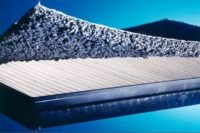DURHAM, UKAfter four years of research, scientists at the University of Durham claim to have created the first magnetic plastic that can be used in everyday products. The polymer, which exhibits magnetic properties at room temperature, represents a marked improvement over previous magnetic plastics that only functioned at very low temperatures.
The new polymer, called PANiCQ, consists of two compounds: polyaniline (PANi) and tetracyanoquinodimethane (TCNQ). PANi is a metal-like electrical conductor that is stable in air. TCNQ has a propensity to form charged particles called free radicals.
"This is only the beginning. From this initial polymer, much better systems can be synthesized in the future," says Naveed Zaidi, a member of Durham's organic electroactive materials group.
According to the research team, which was led by Andy Monkman and also included Sean Giblin and Ian Terry, the material did not exhibit any magnetic properties when first created. However, believing the reaction between PANi and TCNQ would take time to reach completion, a sample was stored in an airtight container for a few weeks and then tested again. This second test revealed that the sample had acquired magnetic properties.
At present, the polymer's magnetism is not as strong as that of conventional metal magnets. But the research team says it is confident that will change.
"The reaction is not yet 100-percent efficient. Once we optimize it, the overall strength will certainly increase," says Zaidi. "The nature of the polymer synthesis means that magnetic properties could effectively be made to measure."
According to researchers, the polymer may some day be used in the magnetic coatings of computer hard discs. In addition, plastic magnets could have important medical applicationsorganic magnetic materials are less likely to be rejected by the body.
